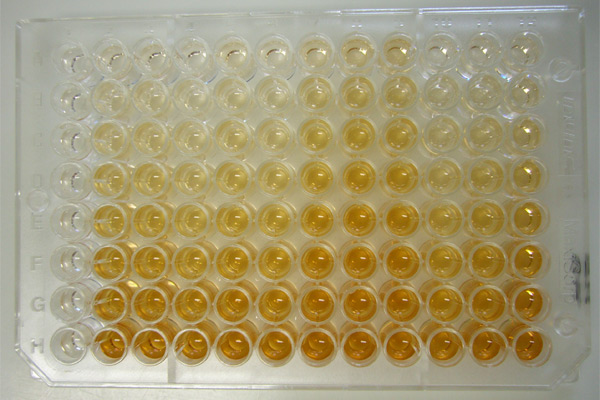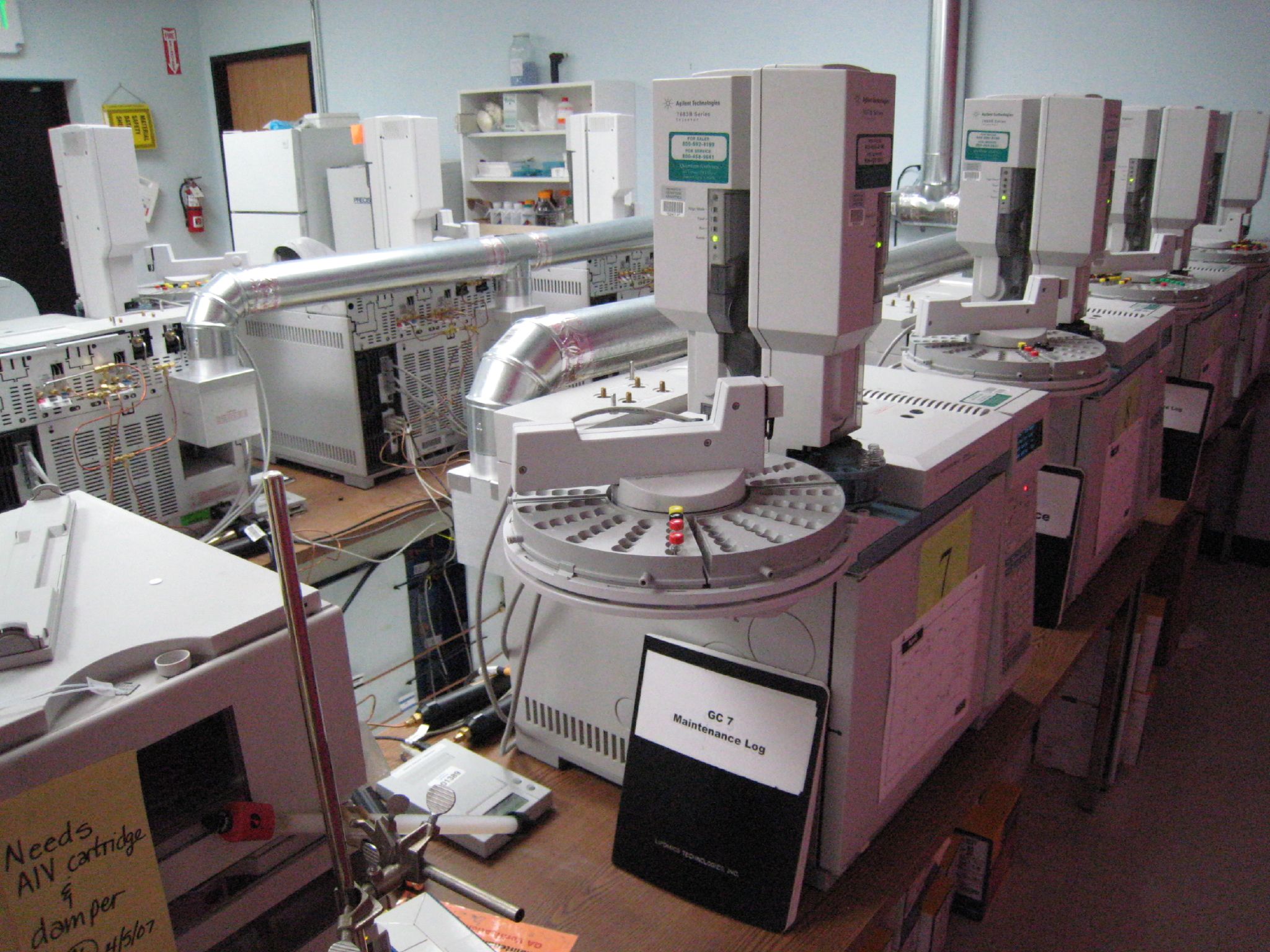|
Analyte
An analyte, component (in clinical chemistry), titrand (in titrations), or chemical species is a substance or chemical constituent that is of interest in an analytical procedure. The remainder of the sample is called the matrix. The procedure of analysis measures the analyte's chemical or physical properties, thus establishing its identity or concentration in the sample. See also *Analytical chemistry * Standard solution *Immunoassay An immunoassay (IA) is a biochemical test that measures the presence or concentration of a macromolecule or a small molecule in a solution through the use of an antibody (usually) or an antigen (sometimes). The molecule detected by the immunoassay ... * Magnetic immunoassay References Analytical chemistry {{Analytical-chemistry-stub ... [...More Info...] [...Related Items...] OR: [Wikipedia] [Google] [Baidu] |
Immunoassay
An immunoassay (IA) is a biochemical test that measures the presence or concentration of a macromolecule or a small molecule in a solution through the use of an antibody (usually) or an antigen (sometimes). The molecule detected by the immunoassay is often referred to as an "analyte" and is in many cases a protein, although it may be other kinds of molecules, of different sizes and types, as long as the proper antibodies that have the required properties for the assay are developed. Analytes in biological liquids such as blood plasma, serum or urine are frequently measured using immunoassays for medical and research purposes. Immunoassays come in many different formats and variations. Immunoassays may be run in multiple steps with reagents being added and washed away or separated at different points in the assay. Multi-step assays are often called separation immunoassays or heterogeneous immunoassays. Some immunoassays can be carried out simply by mixing the reagents and samples an ... [...More Info...] [...Related Items...] OR: [Wikipedia] [Google] [Baidu] |
Titration
Titration (also known as titrimetry and volumetric analysis) is a common laboratory method of Quantitative research, quantitative Analytical chemistry, chemical analysis to determine the concentration of an identified analyte (a substance to be analyzed). A reagent, termed the ''titrant'' or ''titrator'', is prepared as a standard solution of known concentration and volume. The titrant reacts with a Solution (chemistry), solution of ''analyte'' (which may also be termed the ''titrand'') to determine the analyte's concentration. The volume of titrant that reacted with the analyte is termed the ''titration volume''. History and etymology The word "titration" descends from the French word ''titrer'' (1543), meaning the proportion of gold or silver in coins or in works of gold or silver; i.e., a measure of fineness or purity. ''Tiltre'' became ''titre'', which thus came to mean the "fineness of alloyed gold", and then the "concentration of a substance in a given sample". In 1828, t ... [...More Info...] [...Related Items...] OR: [Wikipedia] [Google] [Baidu] |
Chemical Species
Chemical species are a specific form of chemical substance or chemically identical molecular entities that have the same molecular energy level at a specified timescale. These entities are classified through bonding types and relative abundance of isotopes. Types of chemical species can be classified based on the type of molecular entity and can be either an atomic, molecular, ionic or radical species. Classification Generally, a chemical species is defined as a chemical identity that has the same set of molecular energy levels in a defined timescale (i.e. an experiment). These energy levels determine the way the chemical species will interact with others through properties such as bonding or isotopic compositions. The chemical species can be an atom, molecule, ion, or radical, with a specific chemical name and chemical formula. In supramolecular chemistry, chemical species are structures created by forming or breaking bonds between molecules, such as hydrogen bonding, dipole ... [...More Info...] [...Related Items...] OR: [Wikipedia] [Google] [Baidu] |
Chemical
A chemical substance is a unique form of matter with constant chemical composition and characteristic properties. Chemical substances may take the form of a single element or chemical compounds. If two or more chemical substances can be combined without reacting, they may form a chemical mixture. If a mixture is separated to isolate one chemical substance to a desired degree, the resulting substance is said to be chemically pure. Chemical substances can exist in several different physical states or phases (e.g. solids, liquids, gases, or plasma) without changing their chemical composition. Substances transition between these phases of matter in response to changes in temperature or pressure. Some chemical substances can be combined or converted into new substances by means of chemical reactions. Chemicals that do not possess this ability are said to be inert. Pure water is an example of a chemical substance, with a constant composition of two hydrogen atoms bonded to ... [...More Info...] [...Related Items...] OR: [Wikipedia] [Google] [Baidu] |
Matrix (chemical Analysis)
In chemical analysis, matrix refers to the components of a sample other than the analyte of interest. The matrix can have a considerable effect on the way the analysis is conducted and the quality of the results are obtained; such effects are called matrix effects.F. W. Fifield, P. J. Haines. ''Environmental Analytical Chemistry''. Blackwell Publishing, 2000, p. 4-5. . For example, the ionic strength of the solution can have an effect on the activity coefficients of the analytes.Harris, D. C. ''Quantitative Chemical Analysis'', 4th ed. Freeman, 1995, pp.194, 404. . The most common approach for accounting for matrix effects is to build a calibration curve using standard samples with known analyte concentration and which try to approximate the matrix of the sample as much as possible. This is especially important for solid samples where there is a strong matrix influence.Marco Aurelio Zezzi Arruda. ''Trends in Sample Preparation''. Nova Publishers, 2006, p. 15-18. . In cases with comp ... [...More Info...] [...Related Items...] OR: [Wikipedia] [Google] [Baidu] |
Analytical Chemistry
Analytical skill, Analytical chemistry studies and uses instruments and methods to Separation process, separate, identify, and Quantification (science), quantify matter. In practice, separation, identification or quantification may constitute the entire analysis or be combined with another method. Separation isolates analytes. Qualitative inorganic analysis, Qualitative analysis identifies analytes, while Quantitative analysis (chemistry), quantitative analysis determines the numerical amount or concentration. Analytical chemistry consists of classical, wet chemistry, wet chemical methods and modern analytical techniques. Classical qualitative methods use separations such as Precipitation (chemistry), precipitation, Extraction (chemistry), extraction, and distillation. Identification may be based on differences in color, odor, melting point, boiling point, solubility, radioactivity or reactivity. Classical quantitative analysis uses mass or volume changes to quantify amount. Ins ... [...More Info...] [...Related Items...] OR: [Wikipedia] [Google] [Baidu] |
Standard Solution
In analytical chemistry, a standard solution (titrant or titrator) is a solution containing an accurately known concentration. Standard solutions are generally prepared by dissolving a solute of known mass into a solvent to a precise volume, or by diluting a solution of known concentration with more solvent. A standard solution ideally has a high degree of purity and is stable enough that the concentration can be accurately measured after a long shelf time. Making a standard solution requires great attention to detail to avoid introducing any risk of contamination that could diminish the accuracy of the concentration. For this reason, glassware with a high degree of precision such as a volumetric flask, volumetric pipette, micropipettes, and automatic pipettes are used in the preparation steps. The solvent used must also be pure and readily able to dissolve the solute into a homogenous solution. Standard solutions are used for various volumetric procedures, such as determining ... [...More Info...] [...Related Items...] OR: [Wikipedia] [Google] [Baidu] |
Magnetic Immunoassay
Magnetic immunoassay (MIA) is a type of diagnostic immunoassay using magnetic beads as labels in lieu of conventional enzymes (ELISA), radioisotopes ( RIA) or fluorescent moieties ( fluorescent immunoassays) to detect a specified analyte. MIA involves the specific binding of an antibody to its antigen, where a magnetic label is conjugated to one element of the pair. The presence of magnetic beads is then detected by a magnetic reader (magnetometer) which measures the magnetic field change induced by the beads. The signal measured by the magnetometer is proportional to the analyte (virus, toxin, bacteria, cardiac marker, etc.) concentration in the initial sample. Magnetic labels Magnetic beads are made of nanometric-sized iron oxide particles encapsulated or glued together with polymers. These magnetic beads range from 35 nm up to 4.5 μm. The component magnetic nanoparticles range from 5 to 50 nm and exhibit a unique quality referred to as superparamagnetism in the prese ... [...More Info...] [...Related Items...] OR: [Wikipedia] [Google] [Baidu] |





